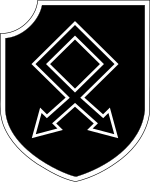23rd SS Volunteer Panzer Grenadier Division "Nederland" (Dutch No. 1)
|
23rd SS Volunteer Panzer Grenadier Division "Nederland" |
|
|---|---|
 Troop registration |
|
| active | February 1945 to May 1945 |
| Country |
|
| Armed forces |
|
| Branch of service | Panzergrenadiers |
| Type | division |
| structure | See outline |
| commander | |
| list of | Commanders |
The 23rd SS Volunteer Panzer Grenadier Division "Nederland" (Dutch No. 1) was created in February 1945 when the SS Volunteer Panzer Grenadier Brigade was renamed "Nederland". The division nominally consisted of Dutch " volunteers ", but in fact the majority of collaborators who had sought their salvation in fleeing to Germany after the Allied liberation of the Netherlands from German occupation , as well as German soldiers from the Wehrmacht and Waffen SS . The division went into Soviet captivity in the Halbe pocket . The division number 23 had previously been assigned to the 23rd Waffen-Gebirgs-Division of the SS "Kama" .
precursor
The division had its origin in the SS-Freiwilligen-Standarte Nordwest, which was formed in April 1941 in Hamburg, the location of the SS-Standarte Germania, which already contained numerous foreign volunteers. This was preceded by the formation of the Nederlandse SS within the National Socialist Movement under Anton Mussert . The SS leadership had decided to include volunteers with "Nordic blood" in the ranks of the Waffen SS for the upcoming campaign in the east. On June 27, 1941, a few days after the attack on the Soviet Union , Reich Commissioner Arthur Seyss-Inquart opened the campaign to recruit volunteers for the "Crusade against Bolshevism", which was led by General Seyffardt , a former chief of staff of the Dutch army .
SS Volunteer Legion Netherlands
The SS-Freiwilligen-Standarte Nordwest, in which Flemings also served, was reclassified into the SS-Freiwilligen-Verband Netherlands in July 1941, as Mussert and Seyffardt had campaigned for a purely Dutch association. On September 24, 1941, the volunteer association was finally renamed SS-Freiwilligen-Legion Netherlands. The Legion had about regimental strength and was used from January 1942 in the war against the Soviet Union , where they captured the Soviet General Vlasov , among others .
4th SS Volunteer Panzer Grenadier Brigade "Nederland"
After suffering heavy losses on the Eastern Front, the Legion was withdrawn from the East in April 1943 and relocated to Sonneberg , where it formed the core of the 4th SS Volunteer Panzer Grenadier Brigade Nederland, now in Dutch spelling. In August 1943 the brigade, which had now reached a strength of 5,500 men, was moved to the Oroslavje / Donja Stubica area in Croatia for further training , where it was also used against partisans , which resulted in numerous war crimes, e.g. B. the murder of prisoners. Here the brigade was also reinforced by 1,500 men who had previously belonged to the 5th SS Panzer Division "Wiking" . In October 1943, the two mechanized infantry regiments were no. 48 and no. 49 its honorary name "General Seyffardt" according to the 1943 killed by the Dutch resistance initiator of the volunteer association, and "De Ruyter" by the Dutch Admiral de Michiel Ruyter from the time of the Anglo-Dutch naval wars . At the end of 1943 the brigade was assigned to III. (Germanic) SS Panzer Corps in the Northern Army Group allocated and returned to the eastern front near Leningrad. In the battle of the Narva bridgehead in the spring of 1944, the brigade again suffered heavy losses and was partially destroyed when the Army Group collapsed in the middle of the summer of that year. After retreating through the Baltic States , the majority of the unit was shipped to Germany in December 1944, where it was reorganized in January 1945 as the 23rd SS Volunteer Panzer Grenadier Division “Nederland”. The SS Panzer Grenadier Regiment 48 "General Seyffardt" stayed behind and was almost completely destroyed in association with the 15th Waffen Grenadier Division of the SS (Latvian No. 1) near Danzig .
Until the end of the war, the division, which never numbered more than 5,200 men, was in action against the Red Army in Pomerania , before it was almost annihilated in the Halbe pocket and taken prisoner by the Allies.
Areas of application
- September 1943 to January 1944 (training and partisan deployment in Croatia)
- January to September 1944 (deployment on the Eastern Front at the Narva bridgehead)
- September 1944 to February 1945 (retreat to Courland )
- February 1945 (fought between Neudamm, Küstrin and Arnswalde; managed to break through to the coast)
structure
- SS-Freiwilligen-Panzergrenadier-Regiment 48 "General Seyffardt"
- SS Volunteer Panzer Grenadier Regiment 49 " De Ruyter "
- Artillery Regiment 54
- Division units 54
Commanders
- October 25, 1943 to May 1945 SS Brigade Leader and Major General of the Waffen-SS Jürgen Wagner (previously commander of the SS Volunteer Panzer Grenadier Brigade "Nederland")
Individual evidence
- ↑ George H. Stein, "The Waffen-SS. Hitler's Elite Guard at War. 1939–1945. “Ithaca 1966, p. 162 f.
literature
- Rolf Michaelis : The Panzer Grenadier Divisions of the Waffen SS. 2nd Edition. Michaelis-Verlag, Berlin 1998, ISBN 3-930849-19-4 .
- Georg Tessin : Associations and troops of the German Wehrmacht and Waffen SS in World War II 1939–1945. Volume 4. The Land Forces 15–30 . 2nd Edition. Biblio-Verlag, Osnabrück 1976, ISBN 3-7648-1083-1 .